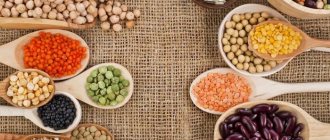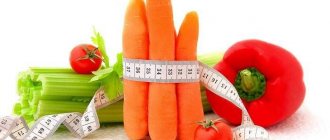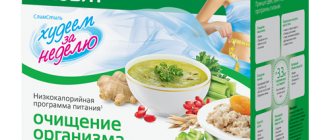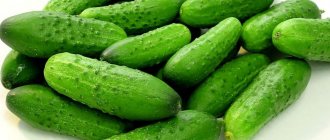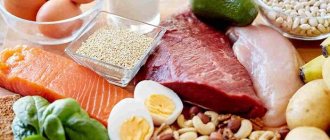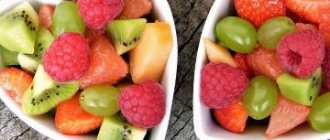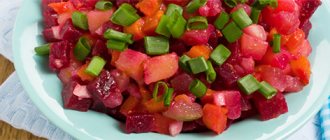- Benefits of legumes
- Harm of legume products
- Application of legume products
| What do we know about a balanced and healthy diet? You need to know when to eat red meat in moderation and completely avoid all kinds of preservatives, flavor enhancers, and trans fats. At the same time, completely giving up fat is also harmful - after all, natural vegetable oils contain a lot of benefits. |
The benefits of fresh vegetables and fruits and seasonal leafy greens are undeniable. The body needs both dairy products and whole grains, unless intolerance to either has developed. We pay much less attention to seeds, nuts and legumes . Yes, nuts can be present in the diet as a healthy snack, aromatic seeds can be used to season a salad or snack, but how often do we enjoy legumes ? What are their benefits? When should you be careful with them? How to cook beans correctly?
What legumes are used in cooking?
Legumes - peas, beans, lentils and soybeans - were used by people for food thousands of years ago; moreover, these products, along with cereals, were the basis of their diet. Hulled legume seeds are used as an independent dish, they are used to cook soups and stews, combine them with vegetables and meat, grind them into flour and bake bread and flatbreads, turn them into filling for pies, cook jelly and make desserts. Green beans and green peas are excellent variations on the theme of legumes; dozens of recipes are presented in the cuisines of the world. Why did humanity fall in love with legumes so much? For ease of cultivation, accessibility, low cost, ease of preparation and culinary advantages, but most importantly, for beneficial and even healing properties for the body.
Description
Cultivated peanut is an annual plant. It reaches a height of 25-65 cm. The root system is branched, its structure is rod-like. The stem of the crop can be pubescent or bare; it is usually divided into 4-5 edges.

According to the location of the side branches, the plant can be in the form of a bush or spread on the ground (depending on the variety).
The leaves are placed alternately on the branches and reach 3-10 cm in length. The leaves can be elongated or pointed, they are pinnate and entire. The petiole and stipule are fused. The culture blooms with small red, yellow or white flowers collected in “brush”-type inflorescences.
The crop bears fruit 120-150 days after planting in the ground. As it grows, pods form on the stem and sag towards the soil. At the moment when the kernels form in them, the pods go deep into the soil, and the formation of fruits on them occurs already in the ground.
To harvest, the plant is dug out of the ground. Depending on the variety, one bush can produce a harvest of from 10 to 150 pods. They are wrinkled and rough, similar in appearance to beans. Just like legumes, the nut is divided into two even halves. In appearance, both the pod and the fruit itself are similar to legumes.
Peanut fruits are oval-shaped, their length varies from 1 to 6 cm. The fruits have a pronounced cobweb pattern. The pericarp is loose and thick. The color of the fruit varies from cream and soft pink to rich dark red, and they ripen in September and October. The fruit consists of 40% oils, which taste somewhat like almonds. In Spain, this oil is used as a lighting material. In all countries, peanut butter is added to margarine (this is an absolutely harmless component of margarine, unlike its other artificial elements). Peanut oil is also actively used in chocolate production and soap making.
What are the benefits of legumes?
Remember about the modern, scientifically based “food pyramid” - it is foods rich in healthy carbohydrates, fiber and vegetable protein that should make up at least 70-80% of a person’s daily diet if he wants to be healthy for as long as possible. Legumes are the best source of plant protein that exists in nature. How is it different from an animal? Because it is much easier for the body to process it and it does not contain harmful fats. This does not mean that you should completely replace animal proteins with plant proteins, although vegetarians do just that. The diet should be balanced, but more plant proteins should be consumed than animal proteins. And with age, animals should be reduced even more in favor of plant foods. In addition to protein, legumes contain vitamins, amino acids and substances that have a positive effect on the cardiovascular system, hormonal levels, intestinal function and immune system. Regular consumption of legumes reduces cholesterol and blood glucose levels and promotes weight loss. Legumes are the basis of a healthy diet at any age, but after forty, they should be eaten at least twice a week. Here is an incomplete list of what is contained in peas, lentils, beans and soybeans: magnesium, potassium, iron, zinc, B vitamins, vitamins A and C, folic acid, arginine, fiber.

Cereals
Groats
– a food product that consists of crushed or whole grains of various crops.
The raw materials for the production of cereals are grains: rice, millet, buckwheat, oats, barley, corn, wheat, sorghum, legumes
, etc.
Cereals are a product of high nutritional value. Cereals are well absorbed by the body, since the inner part of the grain is freed from the shell during the production of cereals. The largest amount of essential amino acids in protein contains: buckwheat, rice, oats
.
All types of cereals contain large amounts of carbohydrates. The physiological norm for cereal consumption is 14-15 kg per person per year. Cereals are a necessary element of children's and dietary nutrition. Cereals are used to prepare various types of cereals, soups, side dishes and food concentrates.
In the menu of peoples of various regions, cereals, in particular rice, replace bread.
Flakes
In addition to cereals, on the shelves of grocery departments in bright, eye-catching packaging you can find products of their industrial processing - flakes
.
Heat treatment is a general technological operation in the production of any flakes. Raw materials - hulled grains or cereals - are either boiled in a sealed boiler, or steamed, or micronized and treated with infrared rays.
Micronization lasts only a few minutes, so cereals made using this technology retain significantly more vitamins and amino acids than porridge cooked on a home kitchen stove.
Disadvantages of Legumes
Almost all legumes, with some exceptions, require pre-soaking; most varieties of beans require 6-8 hours. Lentils, green beans and green peas are the easiest to prepare, but no less healthy. Individual intolerance to legumes is extremely rare, and for many these products cause gas formation. If you want to reduce this effect, change the water several times during soaking.
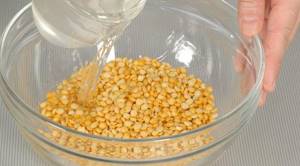
Calorie content and chemical composition
Legumes consist of vegetable proteins (40%), carbohydrates (50-55%), and are rich in vitamins C, PP, provitamin A, as well as mineral salts of calcium, magnesium and iron.
The table shows the nutritional and energy value of the most popular legumes per 100 grams of product.
| Kinds | Proteins (g) | Fat (g) | Carbohydrates (g) | Calories |
| Peas | 5 | 0,7 | 7,5 | 73 |
| Beans | 1,5 | 0,1 | 1,8 | 14 |
| Lentils | 9 | 0,6 | 22 | 119 |
| Chickpeas | 20 | 4,3 | 46 | 310 |
| Soybeans | 35 | 17,5 | 17 | 380 |
| Mash | 23,5 | 2 | 46 | 300 |
| Soya beans | 35 | 25 | 33 | 470 |
| Black beans | 6 | 0,1 | 8,3 | 58 |
| Peanut | 26 | 45 | 10 | 553 |
Contraindications
Legume products can be harmful to the human body, so you need to familiarize yourself with the contraindications to their use:
- Individual intolerance.
- Kidney disease.
- Exacerbation phase of chronic pancreatitis.
- Stomach ulcer.
- Gout.
- Liver diseases (hepatitis, steatosis, hepatosis, cirrhosis).
- Constipation, accompanied by bloating and intestinal cramps.
- Lactation period in women in consultation with a doctor.
- Children's age up to 1 year.
And in conclusion. A balanced consumption of beans in the diet can become a useful habit for people with diabetes, gastrointestinal problems and those trying to lose weight. Regular consumption of different types from the list of legume products will have a positive effect on health, hair skin, and replenish the body with a daily dose of vitamins.
Lobio
250 g of dry beans, 0.5 cups of peeled walnuts, 1 onion, 2 cloves of garlic, 1 large bunch of parsley and cilantro.
Sort the beans and soak in cold water overnight. Drain the water, rinse the beans and, adding fresh water, boil until tender. Place the beans in a colander and save the broth. Peel the onion and garlic and pass them together with the walnuts through a meat grinder. Chop parsley and cilantro. Mix beans, nut butter and herbs, add salt and pepper to taste. If the lobio turns out to be very thick, add a few tablespoons of bean broth.
Pumpkin with beans
450 g pumpkin, 250 g beans, 50 g flour, 2 tbsp. spoons of sunflower oil, garlic, herbs, pepper, salt.
Peel the pumpkin from the crusts and seed pulp, cut into cubes, put in a bowl for cooking, add finely chopped sautéed onions, a little water (100 ml per 1 kg of peeled pumpkin), add the washed beans and cook in a sealed container, stirring occasionally until the beans will not become soft. Then add salt, season with sunflower oil, garlic, crushed with salt, and pepper. Serve the dish hot, sprinkled with herbs.
Harm
If the product is not consumed correctly, it can lead to the development of negative reactions in the body. These include:
- Allergy. It is provoked by the peanut shell, which contains a large amount of allergen. The main features are:
- itching;
- redness of the skin;
- swelling of the larynx;
- vomit.
- Joint diseases. According to Wikipedia, nuts contain a lot of protein, which negatively affects the health of such people.
- Phlebeurysm. People prone to these diseases are advised to remove peanuts from their diet. The product makes the blood thicker.
Carefully!
When peanuts are not properly processed, cleaned, stored, or transported, mold begins to form on their surface. Visually, such nuts look spoiled and taste bitter. To prevent toxins and other harmful substances from entering the body, it is better to completely avoid eating such fruits.
Peanuts can be classified as high-calorie foods in which the vegetable fat content is high. Therefore, people who have problems with excess weight should not get carried away with its use. If you have any doubts about whether you can eat groundnuts or not, it is better to consult a nutritionist. The doctor can tell you exactly how many nuts a day will not harm the body.
Botanical classification of cashew
Cashews grow on a tropical tree formally known as Anacardium occidentale.
Its branches produce a fleshy, pear-shaped stem called the cashew apple. However, this part of the plant is not a fruit.
Instead, the actual fruit is a smaller kidney-shaped structure that grows underneath the cashew apple, also known as a drupe. Inside the fruit you will find an edible seed, which most people know as the cashew nut.
Thus, due to the structural configuration of the plant, the edible part of the cashew is botanically classified as a drupe seed.
The seed and its outer shell are technically considered both a nut and a fruit, but the shell is inedible due to the presence of a toxic substance. This is why you always see only shelled cashew nuts in your local market or grocery store.
Conclusion:
Cashews are botanically classified as seeds because they grow inside the cashew fruit, which is also known as a drupe.
Is it possible during pregnancy and lactation?
Potassium and folic acid enhance the body's protective functions and are involved in the formation and development of the fetus. Therefore, pregnant women should include beans in their diet, preferably boiled.
During the breastfeeding period, a nursing mother can include legumes in her diet only after the baby is 1 month old. Preference should be given to dishes prepared using a minimum amount of salt and spices. During the day you need to monitor the baby’s well-being. If he develops colic or bloating, legumes should be excluded from the diet.
